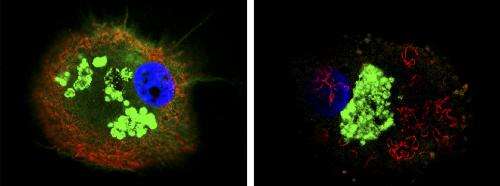A JCB study identifies a motor protein that ferries HIV to the plasma membrane along microtubules, helping the virus escape from macrophages. In these images of a macrophage, the distribution of virus-containing compartments (green) where HIV assembles changes after microtubules (red) are disrupted (right). Credit: Gaudin, R., et al., 2012. J. Cell Biol. doi:10.1083/jcb.201201144
A study in The Journal of Cell Biology identifies a motor protein that ferries HIV to the plasma membrane, helping the virus escape from macrophages.
HIV reproduces inside disease-fighting T cells, killing them in the process. But the virus can also replicate in macrophages, which survive infection and serve as reservoirs of HIV. In T cells, new viral particles are formed at the plasma membrane, but in macrophages the viruses assemble inside cytoplasmic containers called virus-containing compartments (VCCs). To break out of a macrophage, a virus particle therefore has to travel to the plasma membrane.
A group of researchers led by Philippe Benaroch (INSERM, Paris) showed that the virus hitches a ride with the microtubule-based kinesin motor protein KIF3A. The researchers found that reducing the level of KIF3A dramatically reduced the release of HIV particles from macrophages. Yet the procedure did not have any effect on the amount of HIV escaping from T cells. KIF3A drives HIV along microtubules, the researchers discovered; they observed KIF3A proteins and VCCs moving in tandem along the microtubule filaments. Consistent with this, VCCs build up in cells lacking KIF3A, suggesting that their movements stall in the absence of the kinesin. How HIV exits VCCs remains uncertain, but the results indicate that inhibiting KIF3A might offer a new way to combat the virus.
More information: Gaudin, R., et al., 2012. J. Cell Biol. doi:10.1083/jcb.201201144
Journal information: Journal of Cell Biology
Provided by Rockefeller University


















